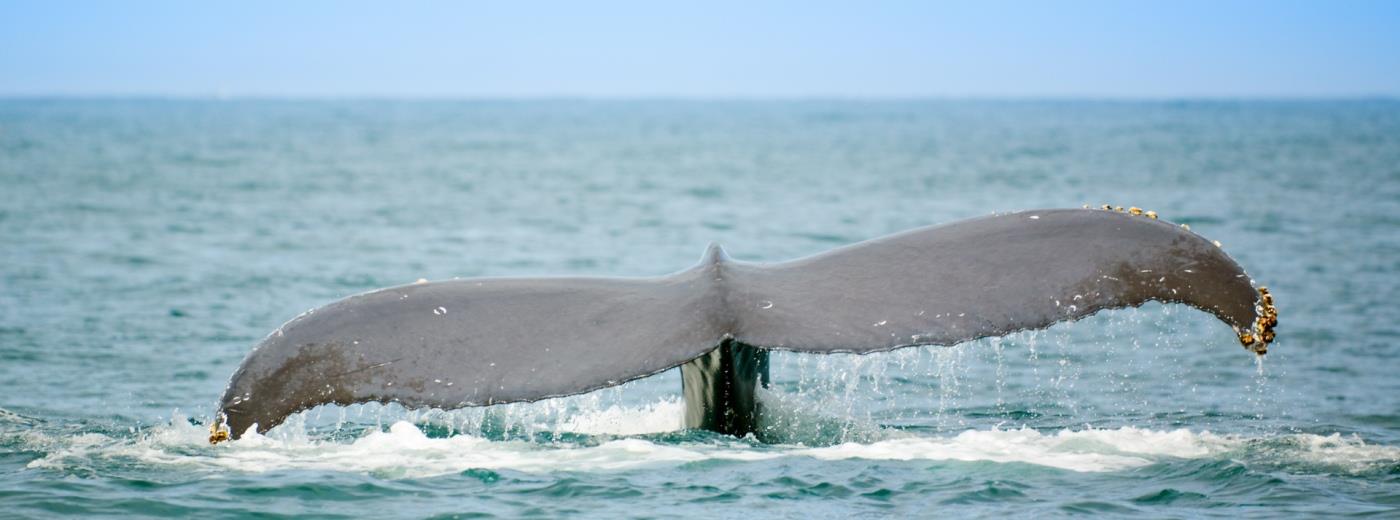Introduction
The Southern Right whale migrates from the Antarctic Ocean to the waters off the south coast annually in June - a journey of over 10,000 kilometres - and returns again in December. They migrate during these Winter and Spring months to mate, calve and rear their young.
About 18m in length (60ft), and weighing up to 80 tonnes, their primary diet is plankton which they filter from the water, slowly swimming through drifting shoals with their mouth wide open to catch them. They have a life expectancy of about 50 years. Their name is derived from its history of being the 'right' whale to hunt and catch, due to it being so rich in oil and extremely slow-moving. There are only about 4,000 - 6,000 Southern Right whales left in the world today.
How to Spot a Southern Right Whale
The Southern Right can be easily identified from other whale species by the fact that it has no dorsal fin on its back and when it breathes out there is a V-shaped cloud above the water - other whales all exhale in a single column.
Each Southern Right whale also has a unique pattern of characteristic pale callosities (outgrowths of tough skin) on their heads - making it possible to actually identify one from the other! Similarly, certain white markings on their bellies or tails are also distinct enough for the animal to be identified by.
This ability to distinguish individual whales has helped scientists track their returning cycles, and they have found that some return each year to the same area along the coastline.
Mating Patterns
One female will mate with a number of males. During mating, there is a lot of activity on the surface (splashing, pushing, shoving, large and frequent blows).
Females usually have one calf every 3 years, and successive breeding seasons are spent mating, calving, then resting. Gestation (pregnancy) is about 11 - 12 months. The females choose sheltered shallow bays with sandy bottoms to give birth to a single calf around August time. The new-born calves grow at a phenomenal rate of 3cm a day - probably why they can drink up to 600 litres of milk a day!
As the weeks go by, the calves become more boisterous and inquisitive, and are often seen breaching playfully around their mothers - also indicative of the fact that long-term bonds are only formed between a mother and her calf - the males disappear after the mating and have no further interest or involvement.
Protection and Hunting Laws in South Africa
Whales are protected in South Africa. These laws were made in 1980 and again in 1984. It is an offence to catch, kill, disturb or harass any whale at any time. These are the offences:
Shooting at any whale.
Approaching any whale in a boat of any other floating craft, aircraft or helicopter closer than 300 metres.
Failing to move away immediately if a whale surfaces within 300 metres of one's boat or other craft.
Stopping or lingering closer than 300 metres to a whale.
Whale Behaviour
Southern Right whales love playing around, and according to whale experts, they enjoy watching us as much as we enjoy watching them! Things to look out for when watching Southern Right whales are:
-
Blowing: A hollow, echoey sound made when expelling air through the blowhole when breathing normally. This is accompanied by a spout of condensed water vapour.
-
Breaching: Breaching is when they lift their bodies out of the water in a massive, graceful leap, and is one of the most spectacular whale habits to witness. Whales will normally breach 3 - 5 times in succession, and can lift three quarters of their body out of the water in one leap, falling back into the water with an almighty splash. This is believed to be a way of communication, exercise or possibly to scratch the parasites off that live on their bodies.
-
Lobtailing: Slapping their tails on the surface is known as lob tailing, and is thought to be a form of communication or a warning message to sharks and other whales.
-
Spy hopping: The head and body are lifted vertically, as far as the flippers, above the surface. This enables them to see what is happening around them above water.

